First Principles on Shipshape Rigging Attachment
There are a myriad of different options for connecting a yacht’s running rigging lines to the sails. Halyards require different functionality from sheets and guys and by the same token, the important criteria vary according to the sail, whether it is fore or main, and up or downwind. This article from Jimmy Green Marine looks at the fundamentals and options for attaching these essential pieces of rigging.
Published 6 months ago
The Fundamentals of Attaching a Halyard to the Head of a Sail
Securing your halyards in a seamanlike manner is a critical part of reliable running rigging. Whether you are coastal cruising, passage making or racing, a robust connection between the halyard and the head of the sail ensures smoother hoists, reduces the risk of failure aloft and helps extend the life of both the line and the sail.
Different sail types present their own rigging demands depending on sail area, expected loads and the frequency of deployment. Here is a breakdown of recommended techniques for attaching halyards to the three key sail groups: headsails, downwind sails and mainsails.
1. Headsails: Jib, Genoa, Staysail
Headsails often need to bear the highest halyard loads on board, particularly when sailing upwind with high luff tension. A compact, high-strength connection at the head of the sail is essential.
Recommended Set-up:
A professionally spliced eye to a side-opening snap shackle or headboard shackle remains the gold standard.
- Side-opening shackles are designed for use with halyards. They reduce the risk of accidental release under load, which is a potential issue with top-opening variants.
- A tight, tapered and contoured splice preserves rope integrity and ensures smooth operation aloft.
Fixed vs Swivel Shackles:
Fixed shackles are often favoured for furling headsails, where halyard alignment is controlled by the foil and swivel.
Swivel shackles, on the other hand, allow the sail head to rotate under load. They’re especially useful on hanked-on or non-furling headsails, helping to relieve halyard twist.
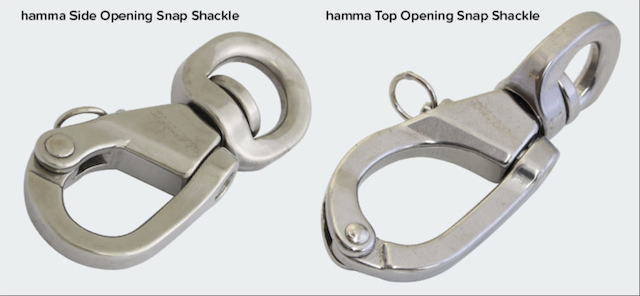

Alternative Option:
Dyneema soft shackles offer a lightweight, low-chafe alternative — ideal for sails with webbing loops. Ensure the soft shackle is correctly sized and tensioned to bear the load it will support.
Headsail Tips:
- Avoid bowlines or other bulky knots at the sail head — they introduce uneven loading and weaken the line.
- Use halyards with minimal stretch.
- Make a full-hoist reference mark on the line to ensure repeatable trim.
2. Lightweight Downwind Sails: Spinnakers, Gennakers, Cruising Chutes, Parasails
Downwind sails rely on unencumbered movement to fill and fly effectively. Attachment points must be secure, capable of efficient deployment and release when it’s time to set or strike, while being kind to both the crew’s hands and the lightweight, delicate sailcloth.
Preferred Options:
- Swivel snap shackles offer excellent articulation at the head and reduce the risk of halyard twist.
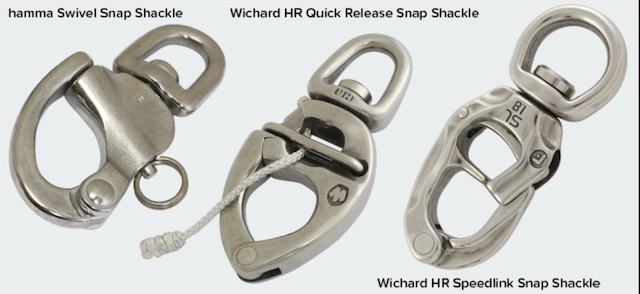

- Versions with quick-release systems, such as lanyard lever or fid-operated, speed up handling during drops or gybes, notably because they facilitate safe release under tension.
Soft shackles are also an excellent choice here. A well-spliced Dyneema soft shackle can be looped through a webbing eye with minimal weight and no abrasive edges, making them ideal for lightweight, vulnerable sails.
Downwind Tips:
- Mark halyards with colour-coded whipping or stitching to identify full hoist positions instantly.
- Coil and stow halyard tails carefully to avoid overrides during pressurised hoists or douses.
3. Mainsails
Main halyards typically run over masthead sheaves and must offer a compact, durable connection. Achieving maximum hoist and avoiding interference at the sheave box are essential factors to consider. Quick-release functionality is rarely needed for the mainsail halyard attachment. Reliability, strength and chafe resistance are the main priorities.
Best Practice:
- Use a slimline profile eye splice finished to a heavy-duty halyard shackle or toggle.
- Select a shackle type that matches any existing sail hardware (e.g. Wichard or Tylaska headboard fittings) to avoid binding or misalignment.
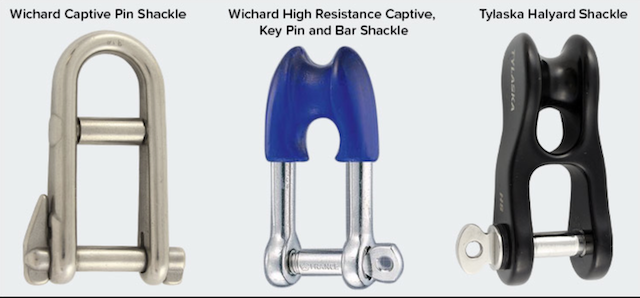

Soft Shackles:
In race settings or ultra-light cruising setups, soft shackles can work well, but only if masthead clearance allows. Be mindful of increased bulk at the sheave entry.
Mainsail Tips:
- Steer clear of bowlines or stopper knots at the headboard. They risk jamming, may not distribute the load evenly and reduce the load capacity of the halyard.
- For maximum durability, consider a Dyneema chafe tip splice, offering targeted protection where the halyard bears the most strain under full hoist.
Final Thoughts: Splicing Over Knots
Knots may be quick and familiar, but when it comes to halyard-to-sail connections, they’re far from ideal. They introduce bulk, create weak points in the line and can shift or loosen under dynamic loads.
By contrast, professionally executed eye splices offer a cleaner, safer and more durable solution. When paired with the proper hardware or soft shackle, where appropriate, splicing delivers a streamlined, high-performance result.
Don’t overlook finishing details: secure whipping at the halyard end is essential to prevent fraying and preserve line integrity. Including a mousing loop also simplifies future replacements.
The Essentials of Attaching the Clew to Sheets and Guys
Proper, secure sheet attachments improve handling, reduce snags and unnecessary wear and ultimately prevent calamitous failure when conditions deteriorate. The most reliable techniques for connecting sheets to headsails, downwind sails and mainsail systems are explored with an emphasis on safety, longevity and ease of use.
1. Headsail Sheet Attachment: Jib, Genoa, Staysail
Headsails need to withstand significant loading, particularly when sailing close-hauled or reaching. The sheet connection must be dependable and compact, but it doesn’t necessarily need to be quick-release, as these lines are rarely removed once set.
Tried and Trusted Options:
- The bowline, tied directly through the sail’s clew ring, remains a favourite for good reason. It’s easy to tie and strong when set, but it should be secured with tape or twine to prevent loosening during flogging.
- Cow hitching a single length of line through the clew is a neat, snag-free method that can’t work loose, although you need to bear in mind that it will not be easily removable. Don’t forget that you’ll need a length of rope that is double the length of a single sheet to make a pair.
Upgrade for Performance:
Dyneema soft shackles, when paired with soft eye splices, offer a lightweight, low-profile solution with impressive strength. Often, a single soft shackle can handle both sheets at the clew.
Dyneema core sheets enable you to reduce the line diameter, thereby reducing stretch without compromising strength. This setup makes winch handling easier on larger headsails.


Bad Practice:
Avoid using any type of metal hardware, such as a snap shackle. Not only will it tend to snag on the guard wire, but it could also be injurious to the crew when going about or lying head to wind.
2. Downwind Sails: Spinnakers, Gennakers, Cruising Chutes, Parasails
These sails are designed to be lightweight, allowing them to fly in light airs, yet powerful enough to handle a stiffening breeze. The choice of sheet attachment needs to reflect both these extremes.
Downwind sail clew attachments should be gentle on the sail fabric yet strong enough to withstand the high loads that increase exponentially with the wind speed. Quick and safe disengagement capability in the event of a collapse or an emergency drop is a must.
Go -To Hardware Options:
- Top-opening snap shackles provide a reliable connection with the option of quick release. The arm hinges at the top so that the line can’t remain hooked at the point of release. Basic models use pull-pins, which can be rigged with a lanyard for an ergonomic pull.
- Quick-release shackles designed for high-load spinnaker work feature a lanyard lever function, enabling release under tension, which allows smooth deployment and retrieval during rapid manoeuvres, gybes or takedowns.
- Trigger-latch snap shackles take it a step further, enabling release under high load with the insertion of a fid or spike, a real asset when conditions are lively.
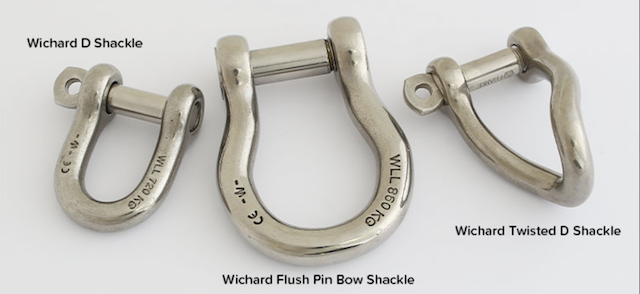


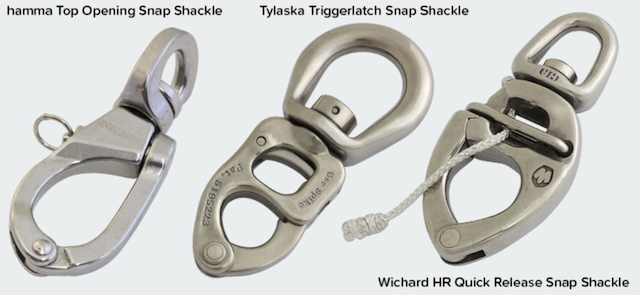

Soft Alternatives:
Dyneema soft shackles are ideal for sails with webbing loops. They reduce flogging damage, eliminate hard contact points and weigh next to nothing.
Cow hitches (also known as Lark’s Head knots) remain a practical solution for asymmetric spinnakers on dinghies or smaller boats, especially when using a continuous sheet.
Tips from the Foredeck:
- Inspect snap shackles frequently for signs of corrosion or wear, particularly the pin mechanism.
- Soft Loops, professionally spliced directly onto snap shackles, keep the connection streamlined and maintain the load capacity of the line.
- Whip all sheet ends and label them clearly to speed up deployment and recovery.
3. Mainsheet Attachments: Boom-End and Top Block Systems
On most yachts, the mainsheet runs through a multiple-part purchase system. The upper block or blocks are typically fixed to a boom fitting, either permanently or with a setup that can be detached when not sailing.
Reliable Mounting Options:
- Webbing straps looped around the boom are common and effective. They spread the load, eliminate the risk of metal-on-metal corrosion, and help limit boom twist under strain.
- Stainless steel boom bales, designed to slot into the boom extrusion, are secure and durable. N.B. Their rigid form can pose a hazard during an uncontrolled gybe.
- Lashings made from Dyneema are a strong, lightweight alternative to webbing.



Finishing the System:
- A small eye splice on the becket is the simplest, strongest way to attach the sheet.
- Always whip the tail of the line to prevent fraying and to make handling easier during manoeuvres.
Final Thoughts from the Jimmy Green Rigging Bench
Even the humble bowline, though widely trusted, has its limits. Under constant flogging or vibration, it can start to work loose, so tape or seize the tail for peace of mind.
Whipping your line ends doesn’t just look pretty. Whipping is functional. A tight whipping not only prevents the end from unravelling, it also binds the rope’s core and cover together, preventing bumpiness or wrinkling along the length. If you can feel bumps when you run the line through your hand, that’s a sure sign that the two braids are out of tension. Whipping, without doubt, prolongs the usable life of any line.
At JimmyGreen.com, our flagship Online Custom Build Splicing and Rigging Service offers the opportunity to specify and order professionally finished and ready-to-deploy sheets and halyards, all at your fingertips with a Wi-Fi or 4G connection. Explore our full rigging range online, or get in touch for helpful guidance from the Jimmy Green Rigging Team.
…………………………………
![]()
About the Author
Jimmy Green Marine is a globally renowned, family-run business founded in 1981, specialising in bespoke rope, wire, webbing and chain solutions.
JimmyGreen.com offers a unique Online Custom Build System, empowering customers to order first-class spliced, terminated, finished and ready-to-fit running rigging, standing rigging, anchoring systems and mooring solutions.
The Jimmy Green Rigging and Sewing Team can offer speedy turnaround times with state-of-the-art WireTeknikRoller Swaging, Cabco Talurit Wire Pressing and UltraSew Automatic Profile Stitching.
Team Jimmy Green is an umbrella for the committed crew that makes up the Splicing, Rigging, Sewing, Sales and Despatch Teams, bringing a wealth of experience and dedication to delivering an outstanding service worldwide.
Their Bespoke Custom Build Solutions are produced from leading Global brands: LIROS and Marlow Ropes, KOS, hamma and Petersen Stainless Steel Wirem and cromox, Hackett, Lofrans, MF and Titan Chain.
Their focus is on select manufacturers to deliver absolute assurance, including a complementary range of supportive deck hardware from Lewmar, Harken, Selden, Barton, to name just a few.
Visit JimmyGreen.com to learn more about their products and services.
…………………………
Related Links:
Other Articles for Noonsite by Jimmy Green Marine:
- Running Rigging – Knowing Your Ropes
- Anchors – What to Consider when Buying or Replacing an Anchor
- Bridles – Extolling the Virtues of V-Shaped Bridles
- Mooring Lines – Horses for Courses
- When to Replace your Standing Rigging
- Ten Reasons to Whip and Stitch Your Ropes
- How to Choose your Next Anchor Chain
- How to Choose a New Halyard
- The Uses and Benefits of Rope Splicing Onboard a Yacht
………………………………
© 2025 Noonsite. This content was edited by Noonsite. Do not reproduce without permission. All rights reserved.
The opinions expressed in this article are the author’s own and do not reflect the view of Noonsite.com or World Cruising Club.
Find out all news, reports, links and comments posted on Noonsite, plus cruising information from around the world, by subscribing to our FREE monthly newsletter. Go to https://www.noonsite.com/newsletter/.
Related to the following Cruising Resources: Cruising Information, Equipment, Planning and Preparation, Sails & Rigging


